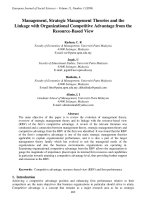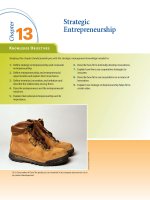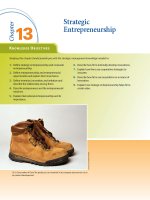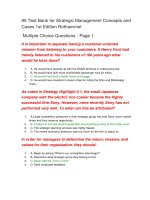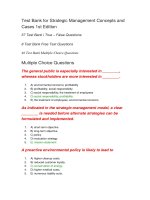Strategic management theory and case study
Bạn đang xem bản rút gọn của tài liệu. Xem và tải ngay bản đầy đủ của tài liệu tại đây (6.27 MB, 92 trang )
Strategic Management: Theory and Case Study
By
Tunchalong Rungwitoo
May 2012
ii
Table of Content
Table of Content.................................................................................................................ii
Table of Table................................................................................................................... iii
Table of Figure ..................................................................................................................iv
Table of Example ...............................................................................................................v
Introduction........................................................................................................................1
Part I: Strategy Formulation ............................................................................................3
1. Organization Mission...................................................................................................4
2 Competitive Situations..................................................................................................7
2.1 External Environment Analysis .............................................................................7
2.2 Internal Environment Analysis ............................................................................16
2.3 SWOT Analysis ...................................................................................................19
3. Developing Strategy...................................................................................................20
3.1 Corporate Level Strategy .....................................................................................21
3.2 Business Level Strategy.......................................................................................33
3.3 Functional Level Strategy ....................................................................................35
Part II: Strategy Implementation...................................................................................38
4. Strategy Implementation............................................................................................38
4.1 Organizational Alignment....................................................................................38
4.2 Leadership and Motivation ..................................................................................41
Part III: Controlling and Evaluation .............................................................................44
5. Controlling and Evaluation ........................................................................................44
5.1 The Controlling Process.......................................................................................44
5.2 Key Performance Indicators ................................................................................45
Power Point Hand Out ....................................................................................................48
References.........................................................................................................................83
iii
Table of Table
Table 1 Starbucks Mission and Components.......................................................................6
Table 2 Missha SWOT Analysis........................................................................................20
iv
Table of Figure
Figure 1 Strategic Management Process..............................................................................1
Figure 2 Strategic Formulation Process...............................................................................3
Figure 3 the Components of External Environment ............................................................7
Figure 4 Thailand Competitiveness ...................................................................................11
Figure 5 Thai Automotive Competitiveness ......................................................................12
Figure 6 Porter’s Five Forces.............................................................................................13
Figure 7 Korean Cosmetic Attractiveness .........................................................................14
Figure 8 The Value Chain..................................................................................................17
Figure 9 Air Asia Value Chain ..........................................................................................17
Figure 10 SWOT Analysis Model .....................................................................................19
Figure 11 Hierarchy of Strategy, Goals and Plans.............................................................21
Figure 12 Corporate Level Strategy Chart.........................................................................22
Figure 13 Three Concentration Growth Strategies ............................................................23
Figure 14 Integration Strategy ...........................................................................................24
Figure 15 Adidas Corporate Strategies ..............................................................................26
Figure 16 BCG Growth - Share Matrix .............................................................................29
Figure 17 Product Life Cycle Curve..................................................................................30
Figure 18 a relationship between BCG Growth-Share Matrix and Product Life Cycle ....31
Figure 19 Corporate Strategy suggested by GE 9 Cell ......................................................32
Figure 20 Industry Attractiveness Evaluation....................................................................32
Figure 21 Business Strength Evaluation ............................................................................33
Figure 22 Example of GE 9 Cell Analysis.........................................................................33
Figure 23 Porter's Generic Strategies.................................................................................34
Figure 24 Functional Level Strategy..................................................................................36
Figure 25 Three primary activities for effective strategic implementation .......................38
Figure 26 Organizatinal Alignment ...................................................................................40
Figure 27 Major Source of Leader Power and Likely Subordinate Reactions ..................41
Figure 28 Maslow Hierachy of Needs ...............................................................................42
Figure 29 Hersey and Blanchard's Situational Leadership ................................................43
Figure 30 The Controlling Process ....................................................................................44
Figure 31 Balance Scorecard .............................................................................................45
Figure 32 The Linkage of Four Perspectives.....................................................................47
v
Table of Example
Example 1 Mission Statement .............................................................................................5
Example 2 Macro Environment Analysis ............................................................................8
Example 3 Thailand National Competitiveness.................................................................11
Example 4 Industry Attractiveness Analysis .....................................................................14
Example 5 Value Chain Analysis ......................................................................................17
Example 6 SWOT Analysis ...............................................................................................20
Example 7 Adidas Corporate Strategy...............................................................................25
1
Introduction
General Management which is the process of achieving organizational goals by engaging
in the four major functions of planning, organizing, leading and controlling1 nowadays
may not sufficient and supportive for the organization succeed in the world of complex
environments. It concerns about the process to manage the company internally but does
not concentrate more on creating competitiveness regarding environments affecting the
organization. Even companies adopt general management to sustain profitability by
reducing the defects or costs, and improving operations process in order to increase
productivity, they may not succeed in the competition because they perform only similar
activities better than competitors but do not create the distinctive competitiveness.
Additionally, they perform only operational effectiveness but not strategy2. Operational
effectiveness and strategy are both essential to superior performance but they work in
very different ways. Strategy is about competitive position that the company performs
different activities from rivals’ or performing similar activities in different ways.3
To learn how the companies create strategies and put them into action, the executives or
strategists should examine carefully an aspect of Strategic Management. Strategic
Management is a process regarding 3 primary activities; Strategy Formulation, Strategy
Implementation, and Controlling and Evaluation4.
Figure 1 Strategic Management Process
2
This paper will be divided into 3 parts regarding the strategic management process which
is shown on Figure 1 and given examples related to Asian stories. The first part is strategy
formulation consisting of 3 components; Organization Mission, Competitive Situations,
and Strategy Development. The second part will express how to implement the strategies.
It engages the organization alignment that should be considered for changing the
organization to support the operations based on the formulated strategies. Finally,
Controlling and Evaluation is a key factor to monitor the organization strategic operations
by considering 4 perspectives: financial perspective, customer perspective, internal
process perspective, and learning and growth perspective.
3
Part I: Strategy Formulation
Strategy formulation is the first activity that company should perform to create unique
competitive advantage by setting the organization mission, analysing the competitive
situations both external perspective and internal perspective, and then developing the
strategies that fits in the environments.
Figure 2 Strategic Formulation Process
Firstly, the organization has to establish its reasons to exist and the scope of operations by
setting its mission statement. Then it should consider the competitive situations that effect
firm operations and competitions. There are 2 perspectives for analyzing the situations.
First perspective is external situations. A strategist should understand macro environment,
national competitiveness, and industry attractiveness whether those factors support or
depress the organization. Second perspective is internal factors. An executive should
examine correlations among the organization activities and business functions, and also
explore the core competencies of the organization.
4
As a consequence, a company will create a competitive advantage from crafting a set of
strategies that gain supportive environments and prevent obstructive factors. A strategist
should classify the environments into 4 groups which are strengths, weaknesses,
opportunities and threats; SWOT Analysis. This classification is very helpful for
developing the strategies via bringing its strengths and opportunities up to create
competitive advantage and explore the possible alternatives to improve its weaknesses
and prevent or avoid the threats. Additionally, this competitive situation arrangement
suggests the organization’s competitive position in the industry and supports conducting
the firm’s strategies.
There are 3 levels of the strategies. Grand strategy or corporate strategy is the highest
level. It is very essential for setting the organizational direction whether firm wants to
grow, stable or exit. Business strategy is the second that the company should describe the
company’s characteristics making competitiveness among the competitors whether it
wants to differentiate by offering the superior values for customers, offering the
affordable price by gaining the low cost advantage, or creating distinctive values for its
concentrated customer5. Consequently, the company will contribute its grand strategy and
business strategy to each business functions in order to craft functional strategies.
Marketing department will conduct marketing plan related to corporate and business
strategies, as well as production and operation plan, human resources plan, and financial
plan.
1. Organization Mission
The organization should set its mission as the organization’s purpose or fundamental
reason for existence. Its organization mission is called as mission statement. It is a broad
declaration of the basic, unique purpose and scope of operations that distinguish the
organization from other of it type 6 . There are 9 components to formulate mission
statement as following:
1) Customers. Who are the organization’s customers?
2) Products or services. What are the organization’s major products or services?
3) Location. Where does the organization compete?
4) Technology. What is the firm’s basic technology?
5
5) Concern for survival. What is the organization’s commitment to economic
objectives?
6) Philosophy. What are the basic belief, values, aspirations, and philosophical
priorities of the organization?
7) Self-concept. What are the organization’s major strengths and competitive
advantages?
8) Concern for public image. What are the organization’s public responsibilities,
and what image is desired?
9) Concern for employees. What is the organization’s attitude toward its
employees?
Example 1 Mission Statement
Starbucks set its mission as the premier purveyor of the finest coffee in the world while
maintaining our uncompromising principles as we grow 7 . The following six guiding
principles will help Starbucks measure the appropriateness decisions;
•
Provide a great work environment and treat each other with respect and dignity.
•
Embrace diversity as an essential component in the way we do business.
•
Apply the highest standards of excellence to the purchasing, roasting and fresh
delivery of our coffee.
•
Develop enthusiastically satisfied customers all of the time.
•
Contribute positively to our communities and our environment.
•
Recognize that profitability is essential to our future success.
From the above mission statement, Starbucks’ missions contain all of nine components
which are shown in table 1
6
Table 1 Starbucks Mission and Components
X
Concern for employees.
public
X
for
Self-concept.
X
Concern
image.
Philosophy.
X
Technology.
X
Concern for survival.
The premier purveyor of the
Location.
Customers.
Starbucks Mission
Products or services.
Components
finest coffee in the world while
maintaining our
uncompromising principles as
we grow.
Provide
a
great
X
work
X
environment and treat each
other with respect and dignity.
Embrace
diversity
as
X
an
essential component in the way
we do business.
X
Apply the highest standards of
X
excellence to the purchasing,
roasting and fresh delivery of
our coffee.
Develop
enthusiastically
X
satisfied customers all of the
time.
X
Contribute positively to our
communities
and
our
environment.
Recognize that profitability is
essential to our future success.
X
7
2 Competitive Situations
The firm can set a suitable strategic vision and strategy by analysing the competitive
situation considering external environment and internal environment.
The external
analysis builds on an economics perspective of industry structure, and how a firm can
make the most of competing in that structure. The internal analysis based on operation
activities and its competencies with in the organization.
2.1 External Environment Analysis
External environment is the uncontrollable factors that effect the organization. Firms
should consider 3 models to amylase its external environment. These are Macro
Environment, National Competitiveness, and Industry Attractiveness.
Legislation and Regulations
Macro Environment
Firm Strategy
and Rivalry
Related and
Supporting Industries
National Competitiveness
Industry Attractiveness
Suppliers
Societal Values
And Lifestyles
Organization
Buyers
General Economic
Conditions
New Entrants
Substitutes
Factor
Conditions
Technology
Demand
Conditions
Population Demographics
Figure 3 the Components of External Environment
8
1) Macro Environment
The first perspective is Macro Environment that affects overall of the business situation.
The company should consider 5 factors which are Legislation and Regulations, General
Economic Conditions, Societal Values and Lifestyles, Population Demographics, and
Technology8. The corporate who expand the business to a global market should consider
all of these factors to be as the information for developing the strategy according to the
host country.
Example 2 Macro Environment Analysis
CP All, a convenience store company in Thailand which granted a license to use the
trademark “7-Eleven”, are expanding the business in Vietnam9 have to consider all of 5
factors affecting the market penetration.
(1) Legislation and Regulations
Vietnam Government’s policy implies to the intention of developing economic growth by
using foreign direct investment such as the reduction the conditional fields of foreign
investment by opening the door to such “sensitive” service fields as banking, finance,
transportation, telecommunications, wholesale and retail, and culture.
10
In addition,
Vietnam is considered to be the country which has a stable socio-political environment
than the other regional countries.11 This is also the one support factor to encourage the
investment. However, Vietnamese strategy declaration focuses on 6 target other countries
for foreign investment.12 This will be the threat for Thai investor that will less prioritize
and faces with the increasing of competitors.
For retail services, C.P.All is influenced from the law to entry in the retail and franchise
service by joint venture and should invest its own stores before it is able to expand its
branch after 3 years.13
9
(2) General Economic Conditions
The economic indicators show the strong GDP growth rate and increases GDP per capita,
investment rate and total retail sector value that expresses the rising of consumer
consumption. However, the inflation rate effect the buying power that may be reduced
from the higher price of goods and services and also the increasing of interest rate may
change the expense to saving and also decrease the investment from bank funding. For
one thing, Vietnam has efficiency employment. There are a few employment rates around
5 % which are male 2% and female 3%. In addition the part-time job increased focusing
on service and retail sectors.
(3) Societal Values and Lifestyles
The economic reform changes Vietnamese values and lifestyles. They require more
standards of living such as hygiene and convenience. People in urban areas normally go
to shopping fresh food and other consuming goods in Supermarkets which is the most
convenient. In addition, Convenience foods are becoming more popular with families to
save their time in preparing and cooking. Moreover, people prefer relaxing in their own
houses with families at night or on days off. As a result, they can spend more money on
home entertainment products such as CD VCD and DVD. 14
Vietnamese are not familiar with buses, and usually have no habit of using a bus in daily
life but the main means of transportation in Vietnamese daily life is motorbikes and
bicycles. Therefore, 7-Eleven ought to locate in gas station.
(4) Population Demographics
Vietnamese population was 83 million in 2005. This total population is predicted to
increase to more than 94 million in 2015. If the Vietnamese population was represented
by a pyramid, it would have a narrow top and wide base. Vietnamese population density
is high in comparison to other countries. As Vietnam is an agricultural country, the
population is mainly concentrated in rural areas which around 80% of the total population
of the country, while only 20% of population lives in urban areas.15
10
Furthermore, the population density is very high and the household preferences that
people live in the rented house. This may imply that there should be a large number of
houses locating nearly with high density. In consequence, 7-eleven should locate in the
house community to offer them the convenience.
(5) Technology
Vietnam is putting considerable effort into modernization and expansion of its
telecommunication system and Information Technology, but the performance has to be
improved and require more investment. Vietnam technology good in the economic main
cities; Hanoi, Da Nang, and Ho Chi Minh City, there are fibre-optic cable or microwave
radio relay network to exchange the information; main lines have been substantially
increased, and the use of mobile telephones is growing rapid16
2) National Competitiveness
For International Business environment, the national competitiveness is an important
factor that a company should see the potential of industry regarding competitive
advantage in the state level. In a world of increasingly international competition, nations
have become more important. Competitive advantage is created and sustained through a
highly localized process. Differences in national values, culture, economic structures,
institutions, and histories all contribute to competitive success. Therefore, the company
should analyze the competiveness in the state level in order to find the opportunities and
threat influenced on the industry that firm challenges. To investigate national
competitiveness, firm should examine The Diamond of National Advantage which
compound of 4 attributes; Factor Conditions, Demand Conditions, Related and
Supporting Industries, and Firm strategy, Structure, and Rivalry.17
(1) Factor Conditions. The nation’s position in factors of production, such as
skilled labour or infrastructure, necessary to compete in a given industry.
(2) Demand Conditions. The nature of home-market demand for the industry’s
product or service.
(3) Related and Supporting Industries. The presence or absence in the nation of
supplier industries and other related industries that are internationally
competitive.
11
(4) Firm Strategy, Structure and Rivalry. The conditions in the nation
governing how companies are created, organized, and managed, as well as the
nature of domestic rivalry.
Example 3 Thailand National Competitiveness
Figure 4 Thailand Competitiveness
Figure 4 shows the competitiveness of Thailand regarding Diamond Model18 suggesting
opportunities for a company to create its own competitiveness. Automotive and tourism
sector have high potential for Thailand competitive advantage. Automotive sector gain
the opportunity from demand condition especially in pick-up truck which is one of the
most developed markets in the world. While the beautiful location and natural resources
are an opportunity for tourism sector.
12
Figure 5 Thai Automotive Competitiveness
Figure 5 is the business environment assessment of Thai automotive cluster.19 There are
many factors supporting automotive corporation in Thailand. This cluster has strong and
growing position in the world export market for pick-up trucks. There is a large
investment from international automakers and cost competitiveness based on low factor
input costs. In addition, automotive makers can access to the skills of foreign assemblers
and gain a strong physical infrastructure as well as a strong presence of locally –based
suppliers. However, there are 2 weak points that automotive firm should consider to solve
them. They are the mismatch between workforce skills and company needs, and lacking
of innovative capacity.
3) Industry Attractiveness
Industry Attractiveness is a competition environment affecting the industry or the market
that the company competes. 5 forces model20 is an important tool to analyze competition
environment and to help the company examine the industry attractiveness. This model is
useful for the company to making a decision for investing or entering to the interesting
industry.
13
Figure 6 Porter’s Five Forces
The 5 forces model is divided in to 2 perspectives. The first perspective, vertical line, is
about the competition in the certain industry regarding 3 factors; Industry Competitors,
New Entrants, and Substitutes. This perspective considers the market challenger in the
current competition by examining the strength of the competitors and the competition
intensive. If the competitors have much more power and the market is high competitive
environment, the industry may not attractive for the new comers. In addition, it considers
the increasing of the new competitors. If there is no barrier for the new entrants, the
competition will be higher and may not attractive in the future. Furthermore, substitute
products are one of the indirect competitors that can gain the customer share from the
market. For another perspective, horizontal line is about the industry operation showing
the correlation among suppliers, producers, merchandises, and buyers. It regard as the
bargaining power of supplier and buyers. If the related units have more power to persist
the product quality, price or other subject that the company are not able to negotiate, the
industry may not attractive to enter.
14
Example 4 Industry Attractiveness Analysis
A Korean cosmetic industry nowadays is not much attractive for the home corporation.
Rivalry among competitors and bargaining power of buyers forces the Korean cosmetic
firms to find new market by expanding business to other country.
Figure 7 Korean Cosmetic Attractiveness
(1) Rivalry among competitors: High
- Large number of brands in the market: There are currently a lot of major
brands already existing in the market with strong foothold, therefore, each brand try to
compete against one another to gain market share especially those major brands.
- Industry growth: With 3.4% increase over 2006, Cosmetic industry has seen as
much consolidated in recent years. Therefore, all brands want to grab this growth to have
its sales volume grow.
- Low product differences: Every brand will follow the market trends to be more
competitive to other brands. Therefore every brand will have nearly the same SKU in
their product category.
(2) Barriers to entry: High
- Brand Identity: Korean people tends to favour European cosmetics over US or
Korean product as European products have traditionally had a more Luxurious brand
images, therefore, the new comer will have the difficulty to enter the market.
15
- Government restriction: There are many documents needed to be submitted to
The Korea Pharmaceutical Traders Association (KPTA) in order to importing product
into Korea.
- Large number of brands in the market: There are currently a lot of majors
brands imported into Korea, also many of Korea local brands increasing their reputation
to Korean market. Therefore there is high barrier of the new comer to enter to the market.
(3) Threat of substitutes: Low
- Substituted product: There are no evident threats as to the possibility of new
products that could replace the cosmetic industry.
(4) Bargaining power of supplier: Moderate
- Differentiation of input: There is low differentiation of input in cosmetic
industry as every supplier need to follow market trend in order to keep the customer
loyalty to the brand.
- Impact of inputs on cost: As the world economy is now very fluctuating
especially the oil price, the price of raw materials are increasing which make the
difficulty of the supplier to maintain the price.
- Threat of forward integration: To integrate with the supplier would need high
cost of investment.
(5) Bargaining power of buyer: high
- Buyer’s needs: Korean people tend to be more health-conscious. They prefer
more natural and green cosmetic products. Therefore they have high bargaining power
which makes every brand to follow the customer’s needs in order to keep the customer
loyalty.
- Market sizes: The entire cosmetics market in Korea is estimated to be worth
about USD 6.1 billion. So customer has many cosmetic brands to choose for themselves.
If product doesn’t meet their preference, they will switch to another brand instead.
- Brand Identity: In the cosmetic market, there are some brands especially
European brands which are in the consumer’s awareness like Chanel, Lancôme, Sisley,
16
LVMH Group, and etc. which can be considered as a brand identity for cosmetic market.
As a result, consumer always considers purchasing those brands as first priority.
- Product differentiation: There is low product differentiation of cosmetic business
as all brands will have nearly the same features and benefits provided to customer. So
customer can change the brands easily.
2.2 Internal Environment Analysis
Besides watching External Environment, The companies should examine the
competitiveness and performance of the firm operations. Corporation can analyze internal
operations by using Value Chain Analysis, Business Function Analysis, and Core
Competencies Analysis.
1) Value Chain Analysis21 is a systematic tool to analyze the interaction among all the
activities a firm performs. This concept divides a company’s activities, value activities,
into the technology and economically distinct activities it performs to do business. A
company’s value activities fall into nine generic categories. They are regarded as the
process to create value considering 2 main activities which are 5 primary activities and 4
support activities. Primary activities compound of the operational factors initiating from
the input of raw materials to operations and output as the finished products delivered to
target customers. For the support activities, there are 4 main factors that firm should
encourage the increasing of competitiveness regarding primary activities. These are Firm
Infrastructure, Human Resource Management, Technological Development, and
Procurement.
A firm gains competitive advantage by performing these strategically important activities
more cheaply or better than its competitors. One of the reasons the value chain framework
is helpful is because it emphasizes that competitive advantage can come not just from
great products or services, but from anywhere along the value chain. It's also important to
understand how a firm fits into the overall value system, which includes the value chains
of its suppliers, channels, and buyers.
17
Support
Firm
Activities
Infrastructure
Human Resource
Management
Technology
Development
Procurement
Inbound
Logistics
Operations
Outbound
Marketing
Logistics
and Sales
Primary Activities
Services
Margin
Figure 8 The Value Chain
Example 5 Value Chain Analysis
Air Asia which is the low cost Malaysian national airline gain the competitive advantage
from performing its operation regarding value chain activities showed on Figure 9
Figure 9 Air Asia Value Chain
18
2) Business Functions Analysis is the basis tools to investigate the organization
performance divided by functions which are marketing, productions, operations, human
resource, and finance etc. For example, executive should explore firm’s market share and
customer satisfaction for marketing analysis. Production analysis is to determine
productivity of the production process and also product quality. Human resource
management is to explore the organizational structure and also the staff competencies.
Lastly, strategist should analyze financial statement considering profitability and liquidity.
3) Core Competencies Analysis 22 is to examine the resources, capabilities and
competencies which considered as the essential factors in the organization. It will lead to
the company core competencies and also the organizational competitive advantage. A
successful company which is flexible for adapting its operation related to the complex
environment has a set of core competencies or capabilities that are difficult for
competitors to imitate and distinguish the company from competition.
An organization’s resources and capabilities23encompass the financial, physical, human,
and organizational assets used in its operations. Financial resources include debt, equity,
retained earnings, and other money related matters. Physical resources include buildings,
machinery, vehicles, and other material items used to operate. Human resources are the
skills, abilities, experience, and other work-related characteristics of the individuals
associated with the organization.
Core competencies 24 is the collective learning in the organization, especially how to
coordinate diverse production skills and integrate multiple streams of technology.
Company should identify the organization regarding 3 factors; a potential access to wide
variety of markets, a significant contribution to end user value, and difficulty for
competitors to imitate. There are many competitive brands gain competitive advantage
from their core competencies such as Sony in miniaturization, allowing it to make
everything from Walkmans to video cameras to notebook computers.
Canon's core
competence in optics, imaging, and microprocessor controls have enabled it to enter
markets as seemingly diverse as copiers, laser printers, cameras, and image scanners.
19
2.3 SWOT Analysis
SWOT analysis is a tool to classify the environment effecting the organization. It
identifies internal and external factors whether they are favourable and unfavourable to
the organization and classifies them into 4 groups which are Strength, Weakness,
Opportunities, and Threats.
Strengths determine internal environments which are the organization’s strong points.
They arise from the resources and competencies available in the firm. Additionally, the
resources advantage relative to competitors and the needs of the markets a firm serves or
expects to serve. Weaknesses are organization’s weak points which are limitation or
deficiency relative to competitors that impedes a firm’s effective performance.
Opportunities determine uncontrollable factors from the external environment that
support the organization activities. Threats are unfavourable situation in the firm’s
external environment and the key impediments to the firm’s current or desired position.
SWOT Analysis involves 2 important parts which are drawing conclusions about the
competitive situations and translating these conclusions into strategic actions to better
match the strategy on its resource strengths and market opportunities, to correct the
important weaknesses, and to defend against external threats.
Advantage
Disadvantage
Internal Environments
Strengths
Weaknesses
External Environments
Opportunities
Threats
Competitiveness
Improvement, Protection
Strategic Actions
Figure 10 SWOT Analysis Model
20
Example 6 SWOT Analysis
Missha, a Korean cosmetic brand, analyze the environment affecting the business
expansion in Thailand on the table 2.
Table 2 Missha SWOT Analysis
Strengths
•
Product quality and variety
•
Reasonable Price
•
Low cost of distribution expense
•
Consumer’s active participation
Weaknesses
•
Ability to understand the different
culture and language
•
Experience in doing business in
Thailand
solution
Opportunities
Threats
•
Korean Trend spread worldwide
•
Strong brand in local market
•
Increasing in health and nature
•
Different consumer behaviour from the
conscious
home market.
•
Increasing of Female world population
•
Decreasing of global economy
•
Global Rising in men’s grooming
•
Increasing of production cost
market
Table 2 shows Missha SWOT Analysis for establishing business in Thailand. This grid
helps Missha to set its marketing strategies regarding strengths and opportunities and find
the solutions to solve its weaknesses and threats. Missha uses its strength in marketing
proposition to communicate to Thai target customer who adopts Korean Trend and is
aware of wellbeing. However, to solves its depress it use joint ventures which are the
mode of entry giving local company who understand Thai culture prepare marketing plan
that suits to Thai behaviour.
3. Developing Strategy
Many organizations develop strategies at 3 different levels: Corporate, Business and
functional. 25 Corporate Level Strategy addresses overall of the organization strategic
direction. For the organization which has a various strategic business unit, it may set the

